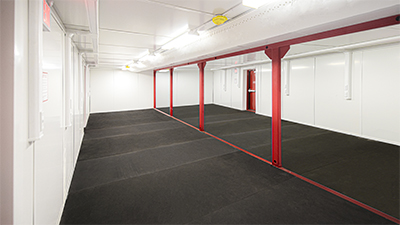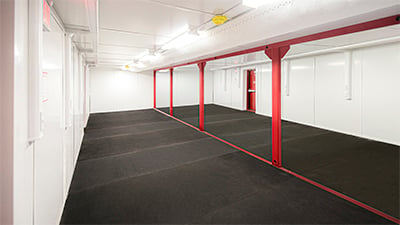
Concrete or steel? It’s probably one of the first questions you’ll be asked the next time you look at adding a new structure to your facility. And rightly so, after all, it’s the one decision that will literally determine the very foundation upon which your structure will be built.
So, which one is right for you? Well, it depends.
At CoverSix, we’re one of the world leaders in the construction of hardened and robust structures and we exclusively use custom-made steel frames, however, depending on the placement and use of your building, we believe concrete may also be a viable option.
To help you make an informed decision, we’ve looked at both concrete and steel-frame construction based on construction efficiency, overall flexibility, strength, durability, safety, sustainability and of course, affordability.
When it comes to the actual construction of a building, the fact that concrete is almost always readily available is a huge advantage. (We say “almost always” because in times of construction booms—especially after a natural disaster—supplies can run low.) That said, concrete construction does require skilled contractors and the time it takes for the material to cure can lead to longer construction times.
With steel construction, the lead time is on the front end since the materials have to be ordered and shipped to the construction site. However, once the materials are on hand, the fact that the steel pieces have been made to the exact specifications of a CAD drawing means that assembly can usually happen within a matter of days.
For design considerations, both concrete and steel have their advantages.
On the one hand, a concrete structure can take virtually any shape—something you just can’t do with steel (even though some amazing things have been done with steel fabrication).
On the other hand, steel has a much higher strength-to-weight ratio than concrete, allowing for the creation of structure that can span great distances without the need for interior columns—resulting in large, open spaces suitable for a variety of uses. If the same design was attempted using concrete, the massive weight of the structure would ultimately lead to collapse.
Another advantage of steel-frame structures is that they are much easier to modify if they ever need to be redesigned or expanded. While a concrete structure would need to be torn down and rebuilt if your needs change, steel structures can simply be added on to until you get exactly what you want.

We already spoke a little about strength, but it’s important to point out that there are actually two types of strength—compressive and tensile.
Compressive strength is a material’s capacity to withstand a crushing force (think top down).
Tensile strength is a material’s resistance to failure when being stretched and pulled (think side to side).
Concrete has amazing compressive strength, but it is actually very brittle when under tension. To counter this weakness, contractors are usually forced to embed steel bars within the concrete (although composite materials are also sometimes used).
By comparison, as the building material with the highest strength-to-weight ratio, steel has both high compressive as well as tensile strength.
It is important to note, however, that both concrete and steel structures can lose strength in prolonged extreme heat, with steel structures being especially at risk. To help offset this threat, most manufacturers of steel buildings—us included—utilize a variety of techniques from fire-resistant coatings and cooling systems to physical barriers and sprinklers.
When finished and sealed properly, concrete structures are incredibly durable and can withstand temperature changes, chemical exposure, sea water, solar radiation, and abrasion. However, if not finished right and regularly maintained, the steel reinforcement within the concrete can become corroded, leading to it losing its bond with the concrete and ultimately deteriorating.
By the same account, steel structures are also susceptible to corrosion, if not properly protected. At CoverSix, we combat this challenge by finishing all of our buildings with a polyurea exterior coating. Polyurea is a highly resilient elastomer which is used as a lining on truck beds and as a coating or lining on steel pipes and tanks.
Safety is a top priority here at CoverSix, and for us, steel is the clear choice.
Our decision to go with steel is primarily based on its incredible ability to stretch and absorb what could otherwise be a destructive force. In addition, the high-strength steel connections used in the manufacturing process actually allows a slight rotation at the joints so that steel beams do not separate under stress.
On the other hand, concrete’s low tensile strength makes it highly susceptible to such a force, which in the real world, could come in the form of an earthquake or a nearby blast or explosion.
Through our own blast tests, as well as industry-wide data, we have seen firsthand the amazing strength of steel structures and their ability to maintain their integrity while protecting the lives of those inside.
As we face a planet with dwindling natural resources, sustainability becomes more and more important each day.
For comparison, about 85 percent of all of the steel used in the world ends up getting recycled while 50 percent of concrete ends up in a landfill.
The benefits of using recycled steel include:
That said, steel—like cement—does create carbon dioxide during the production process; however, innovations in steel production have reduced industry greenhouse gas emissions by as much as 37 percent.
Price. Oftentimes, this is what it all comes down to.
While steel as a raw material is usually less expensive than concrete, its price does tend to fluctuate due to global markets so it might be better to look at the affordability issue from a variety of angles.
From a labor standpoint, the fact that steel-framed buildings are pre-engineered drastically cuts down on construction time. Also, the overall strength of steel means that less material needs to be used.
As far as efficiency is involved, the sheer mass of concrete structures allows them to buffer temperature swings and save money on heating and cooling. To help level the playing field, steel building manufacturers often need to increase insulation. From a personal standpoint, our parent company, RedGuard, has found solutions that meet the requirements of the Canadian Standards Association and have proved successful at mitigating the frigid temperatures in both Canada and Alaska.
As a final point of comparison, steel buildings hold their value for decades without expensive maintenance and they offer the possibility for expansion or to be reconfigured while concrete structures need regular upkeep and offer no easy ways to modify.
There is a time and a place for both concrete and steel-frame construction, but in our opinion, more often than not, steel offers the best value, strength, safety, and durability. To learn more about the steel structures available to you through CoverSix, visit our website or contact us today to learn more.